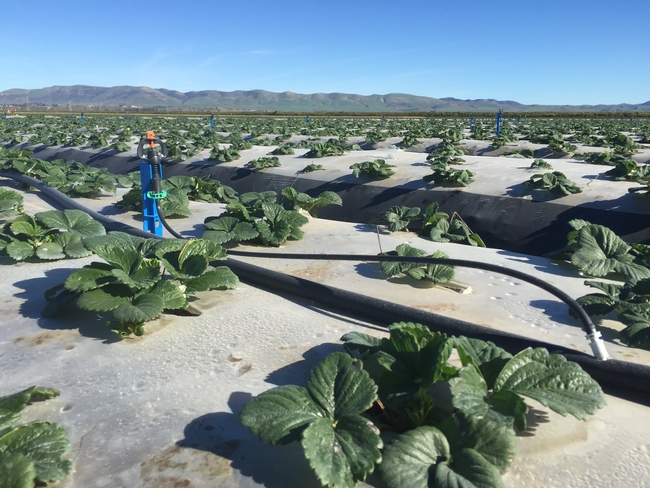
Each fall, strawberry farmers put young strawberry transplants in the ground through holes cut in plastic mulch. Beneath the mulch are drip lines that will serve to irrigate the plants as they reach maturity. But early on, farmers typically install solid-set aluminum sprinklers in the furrows to get the plants started and leach salts below the strawberry plants' root zone.
“In some areas, overhead aluminum sprinkler irrigation is considered very important to prevent dry conditions which could result from Santa Ana winds,” Dara said. “However, the aluminum sprinkler irrigation requires a significant amount of water and can be inefficient.”
During the 2014-15 strawberry season, Dara worked with farmer Dave Peck of Manzanita Berry Farms in Santa Maria to compare micro-sprinklers with the more commonly used aluminum sprinkler systems. The experimental plots were planted in early November and carefully monitored throughout the growing and harvest season, which ended in June. The two types of sprinkler irrigation were used for about one month, then the grower switched to using exclusively the drip irrigation installed underneath the mulch.
Dara found that micro-sprinkler irrigation cut water use by 32 percent compared to the area where aluminum sprinklers were used, and resulted in no significant difference in total marketable yield.
Strawberry plant vigor was measured each month during the study. At first, the plants in the micro-sprinkler treatment area were significantly smaller, but they caught up with the rest by March. Sprinkler irrigation is also thought to help control twospotted spider mites and predatory mites. In Dara's experiment, however, the pests' sparse numbers did not allow for useful data to be collected.
The sprinkler comparison did offer insight on powdery mildew, a serious disease problem, particularly for organic strawberry growers. Sampling for powdery mildew in the plots showed that its severity was significantly less in the micro-sprinkler treatment. Another common strawberry production problem, botrytis fruit rot, was also eased with the micro-sprinkler treatment.
RDO Water and Netafim were partial funders of the project.
The full research report is posted on Dara's eNewsletter.
An initiative to improve California water quality, quantity and security is part of the UC Division of Agriculture and Natural Resources Strategic Vision 2025.
Author: Jeannette Warnert